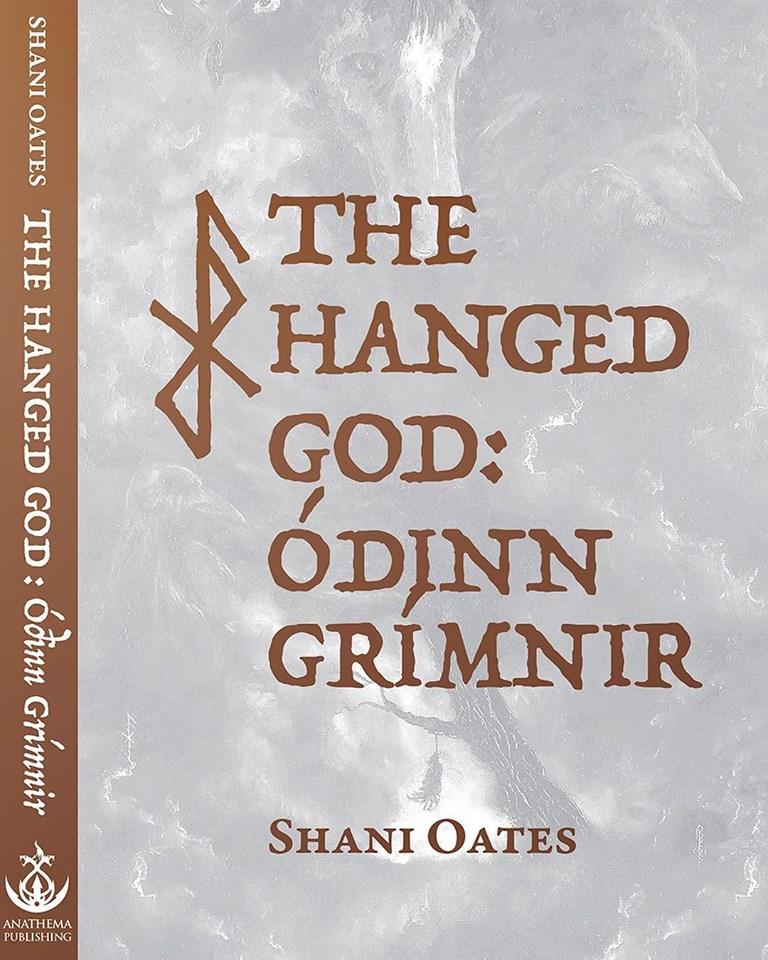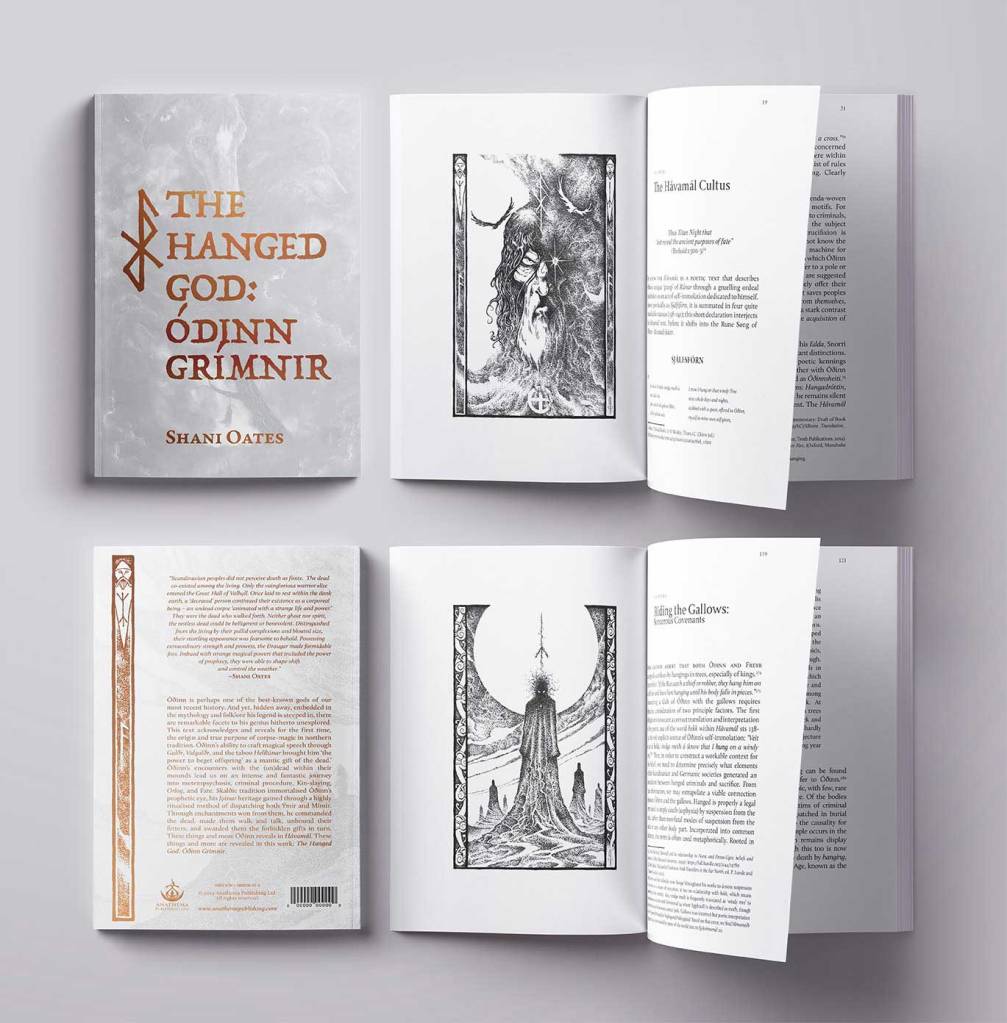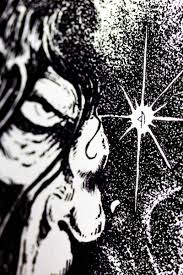
Who would have thought that a small Canadian occult book publisher would publish perhaps one of the most interesting books on Ancient Scandinavian religion and customs this year? This is exactly what has happened with Anathema Publishing’s newest book – The Hanged God: Óðinn Grímnir by Shani Oates. Oates is perhaps best known for her work promoting a strand of Witchcraft dubbed Cochrane’s Craft, which is also known as Cochranianism. This is a strand of traditional witchcraft founded in 1951 by the English witch Robert Cochrane, to which Oates is one of the leading members of at this moment. Anathema has previously published a few of her books on various subjects including The Devil’s Supper and Crafting the Arte of Tradition, both of which were solid reads. Oates does well to write her books in a solid scholarly way, staying clear of overt editorialization in favor of looking into topics such as anthropology and history of a given subject.
The theme of the book is an exploration of one particular passage of a large poetic codex called the Hávamál (sayings of the high one) particularly stanzas 138-141. This series of interconnected poems are set up in such a way as to be the spoken word of Óðinn himself, with this one particular section being one of the more puzzling parts to come to terms with for many scholars.
| 138 I know I hung on that windy tree Nine whole days and nights, Stabbed with a spear, offered to Óðinn, Myself to mine own self given, High on that tree which none hath heard From what roots it rises to heaven. | 140 Nine mighty songs I learned from the great son of Bale-Thorn, Bestla’s sire; I drank a measure of the wondrous mead, With the soul stirrers drops I was showered |
| 139 None refreshed me ever with food or drink, I peered right down in the deep, Crying aloud [screaming] I lifted the runes, Then back I fell from thence. | 141 Ere long I bare fruit, and throve full well, I grew and waxed in wisdom; Word following word, I found me words, Dead following Dead, I wrought deeds. |
.

For a long time, many people have looked at the self-described self-immolation of Óðinn as a way for the writers of such literature to bring Óðinn into the same standing as the burgeoning Christianity by concocting a similar self-sacrifice as that of the Christian Messiah, Jesus Christ. The problem is, as Oates points out, there appears to be a complete missing meaning to these passages that is simply that first topic being – why did Óðinn hang himself? It’s not a sacrifice for his people like Jesus, so why waste the energy? If one looks at things such as similar traditions to reconstruct what ancient Scandinavian rituals might have been like before many traditions were wiped away by missionaries, an entirely different view of this passage comes to light.
Oates discusses multiple ancient cultures near and within Scandinavia showing that many, if not all of them had a similar idea – sacrificial hanging was VERY important. She talks a lot about the Ancient rituals at a site called Gamla Uppasala in Sweden, and how the tradition of the hanging tree was supposedly laid out. I say “supposedly”, because the only surviving descriptions of this are from Christian chroniclers, which are no doubt over-exaggerating this to show “how cruel these barbaric heathens are”.
“A general festival for all the provinces of Sweden is customarily held at Uppsala every nine years. Participation in this festival is required of everyone. Kings and their subjects, collectively and individually, send their gifts to Uppsala; – and – a thing more cruel than any punishment – those who have already adopted Christianity buy themselves off from these ceremonies. The sacrifice is as follows; of every kind of male creature, nine victims are offered. By the blood of these creatures it is the custom to appease the gods. Their bodies, moreover, are hanged in a grove which is adjacent to the temple. This grove is so sacred to the people that the separate trees in it are believed to be holy because of the death or putrefaction of the sacrificial victims. There even dogs and horses hang beside human beings. (A certain Christian told me that he had seen seventy-two of their bodies hanging up together.) The incantations, however, which are usually sung in the performance of a libation of this kind are numerous and disgraceful, and it is better not to speak of them. “

She comes to a conclusion that Óðinn’s ritual suicide was that – a ritual – a way for him to have visions as many ancient shamans would do, or at the very least these were instructions for others to have similar experiences to gain true wisdom. Perhaps, this was in some way something akin to a Native American vision quest that Óðinn had performed – hanging in a tree for nine days without food and water, hallucinating towards the end. And when done, he found one of the most important things – the runes themselves!
The Hanged God: Óðinn Grímnir is a very interesting book and solid read if you don’t mind something a bit scholarly (full of footnotes and the like). I’m VERY glad tis book did not follow a similar path to similar books I’ve read that seek to overturn long-held beliefs of various religions. For instance, I once read a book called The Sacred Mushroom and The Cross: A study of the nature and origins of Christianity within the fertility cults of the ancient Near East by John M. Allegro, where he postulated that the entirety of Christianity was once based on the cultivation and worship of red and white mushrooms for psychotropic reasons. While this book was interesting “food for thought” of the sort you hear on something like the Joe Rogan Experience Podcast, it was not scholarly, and suffered by being a huge list of various instances of confirmation bias.
Thankfully, Oates avoids this by giving tons of evidence with citations for her assertations, and yes some of it is speculation, but it never veers past something that you could see making sense. I’m sure some hardened historians would balk at many of the ideas presented in the book, but that’s the entire point honestly. The book sets out to overturn what they’ve been sitting on for decades.
Anathema is usually a company that releases small print run hardback editions on various esoteric topics, here they are dipping their toe into a paperback line dubbed the Octavo series. While having a paperback has pros and cons of course. I like collecting hardcover books, so I sort of wish this book was available in both formats as I would have likely spent a bit more to get a hardcover. One of the pros here is obviously the cost – this book is CONSIDERABLY cheaper than their other books, even with the insane shipping price it takes to get this over from the far reaches of Canada. The book itself is absolutely gorgeous, covered in luxurious golden foil embossing and striking art pieces on the interiors. Supposedly, Anathema is trying to establish overseas retailers such is an occult book store called Miskatonic books as an American seller, so my issue with the shipping prices might be neutralized soon.
All-in-all this is (so far) one of the better speculative books on this subject I’ve ever read and it is VERY thought provoking. Do I assume everything stated in the book is absolute truth? No. In fact, I thought the ultimate conclusion was sort of too vague too completely wrap everything up. But it’s just as plausible as the historical accounts seeped in Christian afterthought and the need to everything to fit into a modern worldview. Since I now own three books by Oates from Anathema, I honestly should try to check some of her self-published stuff out. While I do not practice witchcraft, the books should be, at least, an interesting read.

For more information, go to:
or
MSRP: $33.00
[…] references to Indian Gods and religion. A counter to this would be a previous book I read called The Hanged God Óðinn Grímnir in which a similar task was done trying to piece together traditions of ritual hanging, but the […]
LikeLike
[…] An excerpt from my previous review here: […]
LikeLike